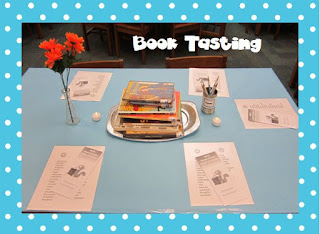Tuesday, December 19, 2017
Thursday, December 14, 2017
Book Tasting
Emma Tackett, 5th grade teacher created a Book Tasting, where four students and four books read for a time then discuss their thoughts about the book. WOW! Great idea!
Reorder and SHARE Your Literacy Teaching Priorities on Schoology
In the beginning of January, it's time to think about what to do, what's important in your classrooms? This is the PAUSE that you have to reorder your priorities in your classroom.
Given all the demands, this process is necessary. Teachers have vast knowledge of content, strategies and students' needs. We juggle, plan, fix and adapt. What are we missing? I offer these key questions as you begin your New Year.
- What's the most important idea about literacy that you want to convey to your students, parents and staff?
- In what ways do you convey reading and writing as life skill that is enjoyable and useful?
- How do you celebrate your literacy victories?
Post your ideas on the Teacher Tools Schoology Group in the Discussion area. Access code for 8M5SS-DVGCZ.
Monday, December 11, 2017
Katherine Patterson wrote Bridge to Teribithia. She recommends the following book for Middle grades.
Ghost by Jason Reynolds
Everything Jason writes seems to turn to gold, but I truly love this book about a young boy who, with help from caring friends and adults, turns running from an abusive father into a race toward a good life. It’s a sports story, but it’s also much, much more.
The Crossover by Kwame Alexander
While on the subject of sports stories that are much, much more, I can’t leave the subject without mentioning Kwame Alexander’s The Crossover. I have a suspicion that nearly every middle school boy in America has already read it and discovered, perhaps to their horrified amazement, that they were sneakily lured into a love of poetry when they thought they were just reading a basketball story.
Ramie Nightengale by Katie DiCamilla
I don’t have to tell anyone that Kate DiCamillo is a wonderful writer, and I could easily just say, “Read anything she writes.” But I will put in a plug for her latest novel, Raymie Nightingale. It made me laugh a lot, but in the end I was laughing through my tears — my favorite sort of reading experience.
Monday, November 20, 2017
ADULTS! Why Not Just READ?
Recently at a group of English, Language Arts teachers had lunch together. I asked the question, so what are you reading. There was silence and some mumbles about not having time from our busy jobs to read. I was surprised! the ELA community? Not even reading for pleasure?
Now, I'm pleading with the adults in my life, at work and at home: just connect with a good book. Reading offers so many benefits for us.
Now, I'm pleading with the adults in my life, at work and at home: just connect with a good book. Reading offers so many benefits for us.
- Take a Mental Time Out - stop and read or listen to a story. Get away from the endless lists and the demands of the phone, the email and the computer.
- Be Transported - to another time, another place and maybe another century!
- Be Amazed or Alarmed - how can a novel be so similar to my life, or how can this story be so mystical and intriguing, or how can this have happened?
- Be Recreated - by the narrative, the characters and/or the message.
- Get Addicted Again - open to ideas, worlds and messages that were hidden or misunderstood. Open up and devour a good book!
Wednesday, November 15, 2017
Kickstart Listening
Deeper
Level Listening Strategies
·
Say It Once or Not At All –
if T repeat instructions, students don’t bother to listen the first time. Train
the class to listen the first time then wait for them to demonstrate their
understanding. Also use silent signal to
get class attention.
·
Turn and Talk –
Prepare them to listen then turn to their shoulder partner and explain what you
just said. This allows you to know what they have grasped. Useful for ELL
classes and special needs students but boosts learning overall.
·
Student Hand Signals –
non-verbal signals succeed in higher student engagement. “hold up one finger if you strongly agree, two
if you agree, three if you’re unsure, four if you disagree and five if you
strongly disagree.” Also, raise two fingers if you have something to add, three
if you have something new to say.
·
Pay Attention, Pause, Paraphrase –
when students talk in small groups, give them roles: speaker and listeners.
Listeners are to JUST listen and try not to form a response. When the speaker
finishes, the listener paraphrases what was said and then asks a follow up
question. Video uses Science current events and key ideas.
· Whole Body Listening –
awareness of hearing, ways to focus on what is being said. “Where are your eyes,
hands, mind, heart?”
Training the Brain to Listen HEAR Strategy
· Halt: Stop whatever else you are doing, end your other thoughts,
and free your mind to pay attention to the person speaking.
· Engage: Focus on the speaker. Turn your head so
that your ear is toward the speaker
· Anticipate: Look forward to what the speaker has to
say, “You may learn something new and interesting.”
· Replay: Think about what the speaker is saying.
Analyze it in your mind or discuss with a partner.
Wilson,
Donna, PhD. "Training the Brain to Listen." Edutopia. George
Lucas Foundation, 22 Jan. 2014. Web. 24 July 2017.
“Most
of the successful people I've known are the ones who do more listening than
talking.”
-Bernard Baruch
-Bernard Baruch
Speaking Kickstart Suggestions for Classrooms
Speaking: Discussion
Strategies
·
Stations - set up the classroom to
have stations with items to stimulate discussion around a prompt or a task for
small groups
·
Gallery Walks – students create an
informative poster then talk about it to others who circulate around the room
or a team of students create materials that are posted and then viewed in a
walk
·
Physical Barometer – a statement is read and
students move to one corner of the room or the other to indicate their choice.
Can add “strongly” to agree or disagree and have four corners. Students discuss
their ideas.
·
Pinwheel Discussions – four students discuss
an issue or text, with provocateur’s
challenging them to go farther, think deeply
·
Socratic Seminar –
students sit in a circle as the leader asks an open ended questions to prompt
answering with evidence from a source
·
Concentric Circles – Student form two
circles (outside and inside) They pair with the person they face then rotate to
face another. Useful for discuss content or give opinions on topics
·
Fish Bowl – two students sit face to
face in the middle of the room with others circled around them. They can create
a conversation around a topic or skill and the others observe, take notes and
follow up.
Encourage them to speak by asking them to
• Restate what their partner said
• Paraphrase what others have said
• Give evidence to back up ideas or arguments
• Listen intently then solve a mystery or problem
• Think aloud to answer questions
• Choral read a passage
Oracy
“Elevate speaking to the same level as reading and writing.” Peter Hyman,
School 21, London, UK
Oracy – the ability to speak well
The Goal: every student speaks in every class, every day.
Discussion guidelines are taught and practiced.
Common Core State Standards for Speaking
Engage effectively in a range of collaborative discussions (one-on-one, in groups, and teacher-led) with diverse partners on grade level topics, texts, and issues, building on others' ideas and expressing their own clearly.
Subscribe to:
Posts (Atom)
Scenarios for Opening Schools
This is the most well thought out article that I have read about possible scenarios for opening schools. Jennifer Gonzalez - Cult of P...

-
This was taken from Dr. Averil Coxhead's work on Vocabulary at the following link: Vocabulary Tiers and Samples Common Core Voc...
-
C S E T is Links to Videos Simple Text Evidence What is Text Evidence? Cartoon Video: Fact/Opinion, Claims, Evidence L...
-
Links Analyzing Text (Literature) and Finding Evidence Video Implicit/Explicit Lesson using Movie Trailers Textual Evidence: Implici...










